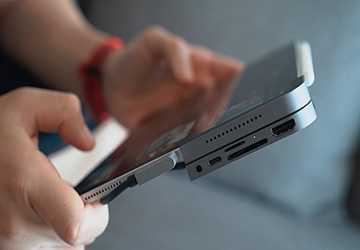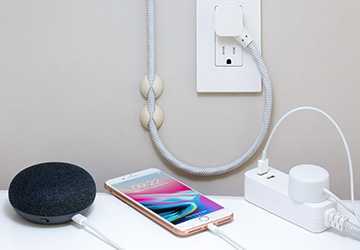USB-C: The Future of Connectivity
Understanding the transition: USB-C vs. USB-A
When we talk about USB-C vs. USB-A, it's important to note that USB-A has been the industry standard for nearly two decades. This is the rectangular connector you're used to on computers, chargers, and many other devices. However, as technology advances, the limitations of USB-A become more apparent. USB-C emerged to address these limitations. The advantages of USB-C are many. It's reversible, so you don't have to struggle to insert it correctly. But this only scratches the surface. USB-C offers higher data transfer rates, faster charging options, and the ability to use multiple functions at the same time, such as video output and power. USB-C's versatility makes it an obvious choice for future hardware development and pushes USB-A into obsolescence.

Versatility: One port does it all
The most compelling advantage of USB-C is its versatility. Traditional ports are often limited to a single function; HDMI, for example, is used for video, while older USB-A is primarily used for data transfer and charging. With USB-C, you have a port that can take on multiple roles. Do you want to charge your device? The same port can do this. Do you need to transfer data at lightning speed? It's the same port again. The future of USB-C will take us to a world where a single port can handle nearly all our connectivity needs. This makes the device simpler, slimmer, and more user-friendly.
Speed Factor: Fast Data and Power Transfer
In our rapidly evolving digital world, speed is a crucial factor. When it comes to data transfer speeds, USB-C has a clear advantage. It can transfer data at up to 10Gbps, twice as fast as the fastest USB-A. The advantages of USB-C are also significant when it comes to charging. Devices charge faster, delivering up to 100 watts of power from a single cable. This means faster charging times for everything from smartphones to laptops, highlighting the future of USB-C as a standard for fast and efficient power transfer.
Compatibility and Acceptance: A Universal Future
One of the most exciting aspects of the future of USB-C is its increasing popularity in various devices. From the latest smartphones and laptops to peripherals like headphones and even monitors, USB-C is quickly becoming the universal standard. As USB-C adoption increases, benefits such as faster data transfers, universal compatibility, and a simplified user experience will likely become commonplace, bringing us closer to a single, unified way to connect.
Ease of use: the reversible revolution
An often overlooked benefit of USB-C is its user-friendly design. Unlike its predecessor, USB-A, which had a specific orientation, USB-C is reversible. This may seem trivial, but anyone who uses USB-A cables, especially in low-light locations, will appreciate this advancement. The reversible feature eliminates the need for multiple insertion attempts and ensures a seamless experience.
Expand your horizons: Docking solutions and multiport adapters
Regarding connectivity, USB-C's benefits also extend to docking stations and multiport adapters. You can connect multiple peripherals such as mice, keyboards, and external monitors through a USB-C port. USB-C hubs typically feature a traditional USB-A port, an SD card slot, and an Ethernet port, turning your USB-C port into a versatile power source. This expandability highlights the future of USB-C as a universal port that reduces clutter and simplifies user setup.

Universal charging: the one cable solution
USB-C isn't just for data transfer; It's also becoming a universal charging solution. The benefits of USB-C charging extend beyond smartphones and laptops. Imagine a future where you can use the same cable to set up your phone, laptop, or electric car. Companies are already exploring USB-C as a universal charging standard, which could have far-reaching consequences for reducing e-waste and simplifying our lives.
Forward and backward compatibility: a bridge to the future and the past
USB-C is designed for the future. What's also interesting is that it pays homage to the past by being compatible with older standards via adapters. This feature means you don't have to discard your old devices as you transition to a USB-C future. Adapters convert USB-C to USB-A, HDMI, VGA, and other connection types, extending the life of older peripherals and reducing waste.
Optimized user experience: duality combined with comfort
When we talk about the benefits of USB-C, one of the critical advancements is its user-centered design approach. No more squinting or bending over in the dark to ensure your USB cable is plugged in correctly. The front and back design of USB-C allows us to get rid of the one-sidedness of USB-A. This design advancement makes connecting devices easier and more efficient, eliminating the need for the familiar "flipping USB" ritual.
Modularity at its best: USB-C's role in docking stations and multiport solutions
USB-C's versatility goes far beyond simply transferring data or power. It acts as a unified interface for all types of connections, evident in docking stations and multiport adapters. USB-C connectivity turns your laptop into a full-featured workstation with multiple monitors, external hard drives, and other peripherals. This makes the future of USB-C the backbone of modern workplace solutions, reducing clutter and increasing efficiency in one fell swoop.
All in all, USB-C is not just an upgrade but a revolutionary step in connectivity. Its versatile design, data processing capabilities, and speed set the stage for future devices and should be an essential consideration for anyone looking to invest in a new device. The advantages of USB-C cannot be ignored, and as the technology continues to evolve, its status as the connector of the future becomes increasingly undeniable.
Related Posts
- 4 Amazing Features of Wearable Health Tech Set to Revolutionize Wellness in 2023
- Where to Find Affordable Home Security Cameras
- Who Needs a Mechanical Keyboard and Why?
- Top 10 Laptops for College Students in 2023
- What to Look for in Gaming Monitors for Professional Gamers?
- 6 Eco-friendly Devices Every Sustainable Tech Lover Needs